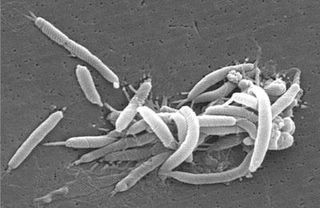** Nobel Medicine

On Monday, two Australian doctors, Barry Marshall and J. Robin Warren, met at a pub in Perth to drink beer and wonder what it would be like to win the Nobel Prize for medicine. While at the pub, they won that prize, along with $1.3 million, a gold medal, and handshakes from the king of Sweden.
Marshall and Warren are the dauntless doctors who discovered that bacteria--and not stress or diet--generally cause stomach ulcers. At first, traditional medicine laughed at the notion. Dr. Marshall actually had to infect himself to prove it was true.
Early scorn aside, the discovery changed stomach ulcer treatment, and it may change medicine itself, as part of "Germ Theory, Part II." But hold on there, Nobel doctors. What's "Germ Theory, Part I"?
Today's Knowledge
Germ Theory, Parts I and II
The idea that disease is caused by invading microbes is really rather new. It wasn't until the mid-19th century that scientists learned that "germs" could multiply inside your body and make trouble. And it wasn't until far more recently that they discovered just how various that trouble can be.
Germ Theory, Part I
In 1864, the French scientist Louis Pasteur (who succeeded in developing vaccines for anthrax and rabies) concluded that some really bad microbugs can live in the air. By 1876, Robert Koch, a German, had extended Pasteur's observation into a discovery of huge medical significance. Koch proved that tuberculosis, a scourge of the 19th century, was transmitted through a specific type of airborne particle.
Koch's discovery--that specific diseases are caused by specific pathogens--revolutionized medicine. He famously outlined four postulates for linking microbes to diseases:
1. A specific microorganism is always associated with a given disease.
2. The microorganism can be isolated from the diseased animal and grown in the lab.
3. The cultured microbe will cause disease when transferred to a healthy animal.
4. The same type of microorganism can be isolated from the newly infected animal.
For the first time, doctors had a "Germ Theory" they could use to investigate disease in the lab and diagnose people in the world. Koch's postulates still stand as a way to determine whether a specific microorganism causes a disease.
And Now, Part II
But doctors aren't resting on their laurels. Today, some scientists believe that many diseases we now attribute to myriad causes--such as cancer and heart disease--may actually be caused by pathogens. It's "Germ Theory, Part II," and research on stomach ulcers has paved the way for its broader acceptance.
For years, doctors blamed stomach ulcers on spicy diet, aspirin irritation, or stress. But in 1982, Australian doctors Barry Marshall and J. Robin Warren discovered that when ulcer patients with stomachs full of spiral bacteria (Helicobacter pylori) were given antibiotics, their stomach pains and ulcers disappeared.
At first, the clinical community ignored their research. So Marshall took extreme measures. In 1985, he swallowed a cocktail of spiral bacteria and proved that the bacteria do cause stomach ulcers. With antibiotics, up to 90 percent of stomach ulcers can be tamed. Even better, a simple breath test can detect the pathogen.
This kind of evidence has some doctors believing that diseases we attribute to genes or the environment are really caused by germs. For example, patients with coronary heart disease tend to have a lot of antibodies to the virus Chlamydia pneumoniae. Does that suggest heart patients may be battling an infection that triggered inflammation, plaque, and ultimately arterial blockage? Some doctors think so--and say that, one day, we'll pin heart attacks on a germ.
Michael Himick and Christina Catron
October 4, 2005
~ Knowledge News Magazine



2 Comments:
Thanks Radica for this very interesting document.
Pierre Paris 11.55pm
Another in a series of intelligent and informative writings presented here..Once again..illuminating!!!
Craig
Post a Comment
<< Home